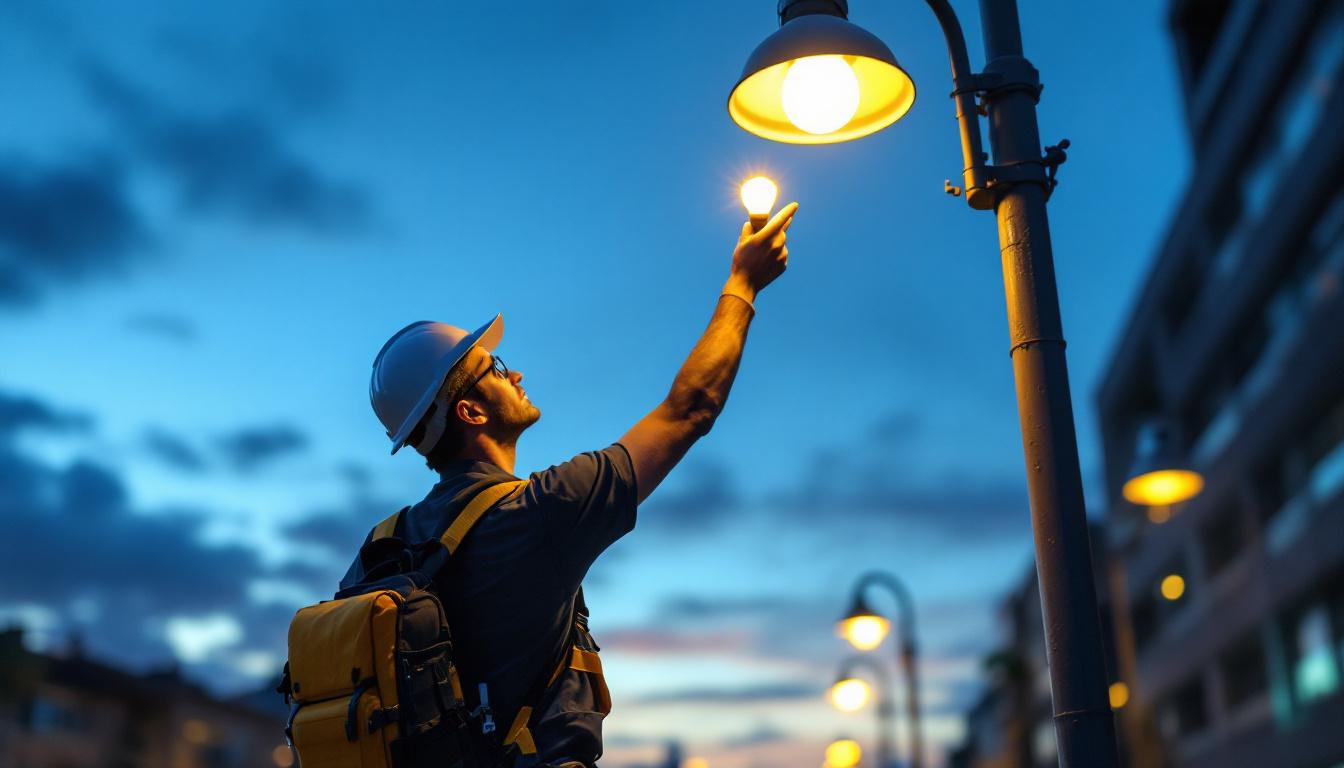
Street lighting plays a crucial role in urban safety and aesthetics. As a lighting contractor, selecting the right light bulbs for street lights is essential not only for functionality but also for energy efficiency and longevity. However, there are common pitfalls that can compromise the effectiveness of street lighting projects. This guide aims to help lighting contractors navigate these challenges and make informed decisions.
The choice of light bulbs for street lights can significantly impact visibility, safety, and energy consumption. Different types of bulbs offer various benefits and drawbacks, making it essential to understand their characteristics before making a selection.
Street lights typically use several types of bulbs, including LED, high-pressure sodium (HPS), and metal halide. Each type has its unique features:
When selecting light bulbs for street lighting, several factors should be taken into account:
In addition to these factors, the installation and maintenance of street lighting systems should not be overlooked. Proper installation ensures that lights are positioned optimally to avoid dark spots and maximize coverage. Regular maintenance is also crucial, as it helps to prevent outages and ensures that the lighting remains effective throughout its lifespan. Communities are increasingly investing in smart technology that can alert maintenance teams when a bulb is out, allowing for quicker repairs and enhanced safety for pedestrians and drivers alike.
Furthermore, the aesthetic aspect of street lighting is becoming more prominent in urban planning. Cities are exploring various designs and styles of street lights that not only serve a functional purpose but also contribute to the overall beauty and character of the area. Innovative designs can enhance public spaces, making them more inviting and enjoyable for residents and visitors. As urban areas continue to evolve, the integration of art and technology in street lighting will play a pivotal role in shaping the urban landscape.
Even experienced contractors can make mistakes when selecting light bulbs for street lights. Here are some of the most common errors to avoid:
Each municipality may have specific regulations regarding street lighting, including wattage limits, light pollution standards, and color temperature guidelines. Failing to adhere to these regulations can lead to costly rework and project delays. Always research and understand local codes before making a decision.
The surrounding environment plays a significant role in the effectiveness of street lighting. For instance, areas with heavy vegetation may require different lighting solutions compared to urban settings. Additionally, the potential for light pollution should be considered, as excessive brightness can disturb wildlife and affect the quality of life for residents.
Maintenance is a critical aspect of street lighting that is often overlooked during the selection process. Choosing bulbs that are difficult to replace or require specialized tools can lead to increased maintenance costs and downtime. Opt for bulbs that are easy to access and replace, ensuring that maintenance crews can efficiently manage the lighting system.
Energy efficiency is a primary concern for municipalities looking to reduce costs and environmental impact. The choice of light bulbs can significantly influence energy consumption and overall sustainability.
Each type of light bulb comes with an energy rating that indicates its efficiency. Familiarize yourself with these ratings to make informed decisions. For example, LED bulbs typically have a higher lumens-per-watt ratio compared to HPS or metal halide bulbs, making them a more energy-efficient option.
While the initial cost of LED bulbs may be higher than traditional options, their longevity and energy savings can lead to substantial cost reductions over time. Conduct a long-term cost analysis to evaluate the total cost of ownership, including installation, maintenance, and energy consumption.
The color temperature of street lighting can significantly affect visibility and safety. It is essential to select the appropriate color temperature based on the specific needs of the area being illuminated.
Warm light (typically around 2700K-3000K) creates a more inviting atmosphere, making it suitable for residential areas. In contrast, cool light (4000K-5000K) enhances visibility, making it ideal for high-traffic areas and intersections. Understanding the context of the installation will guide the selection process.
Research indicates that the color temperature of street lighting can influence crime rates and perceptions of safety. Cooler temperatures tend to improve visibility, which can deter criminal activity. Therefore, selecting the right color temperature is not just about aesthetics; it is also about enhancing public safety.
As technology advances, smart lighting solutions are becoming increasingly popular in street lighting applications. These systems offer numerous benefits, including energy savings, improved maintenance, and enhanced control.
Smart lighting systems can be programmed to adjust brightness based on real-time conditions, such as traffic flow or ambient light levels. This adaptability can lead to significant energy savings and reduced operational costs. Additionally, smart systems can provide valuable data for maintenance schedules and performance monitoring.
Integrating street lighting with other smart city technologies can enhance overall urban management. For example, connecting street lights to traffic management systems can optimize traffic flow and reduce congestion. Lighting contractors should consider how their installations can fit into broader smart city initiatives.
A comprehensive site assessment is crucial for determining the best lighting solutions. Lighting contractors should evaluate various factors that can influence the effectiveness of street lighting.
Before installing new lighting, it is essential to assess the existing infrastructure. This includes evaluating the condition of poles, wiring, and other components. Understanding the current setup can help inform decisions about the type of bulbs and fixtures to use.
Engaging with the community can provide valuable insights into their lighting needs and preferences. Conducting surveys or public meetings can help gather feedback on proposed lighting solutions, ensuring that the final design meets the expectations of residents.
The installation process is just as important as the selection of light bulbs. Proper installation ensures that the lighting system functions optimally and meets safety standards.
Each type of light bulb comes with specific installation guidelines that should be followed closely. Adhering to these guidelines ensures that the bulbs operate efficiently and have a longer lifespan. Failure to follow manufacturer instructions can lead to premature failures and increased maintenance costs.
Investing in training for installation teams can significantly improve the quality of work. Ensuring that contractors are knowledgeable about the latest technologies and installation techniques can lead to better outcomes and fewer mistakes during the installation process.
Once the street lighting system is installed, ongoing evaluation is necessary to ensure it meets performance expectations. Regular assessments can help identify areas for improvement and adjustments.
Using light meters to monitor illumination levels can help determine if the installed lighting meets the required standards. If certain areas are under-illuminated, adjustments may be necessary to enhance visibility and safety.
Soliciting feedback from the community and users of the streets can provide valuable insights into the effectiveness of the lighting. Understanding how the lighting impacts safety and visibility can guide future projects and improvements.
Selecting the right light bulbs for street lights is a multifaceted process that requires careful consideration of various factors, including energy efficiency, color temperature, and community needs. By avoiding common mistakes and staying informed about the latest technologies, lighting contractors can ensure successful street lighting projects that enhance safety and improve the quality of life for residents.
Ultimately, the goal is to create a well-lit environment that meets the needs of the community while being mindful of energy consumption and maintenance considerations. Through diligent planning, execution, and evaluation, lighting contractors can contribute to safer and more vibrant urban spaces.
Ready to elevate your street lighting projects with the best in class lighting solutions? At LumenWholesale, we provide lighting contractors like you with the highest quality, spec-grade lighting products at unbeatable wholesale prices. Say goodbye to local distributor markups and hello to a vast selection of reliable, high-performance lighting that meets the strictest industry standards. Plus, with free shipping on bulk orders, you can get premium lighting at the best value — all without hidden fees or compromises. Don’t miss out on the perfect combination of quality, affordability, and convenience. Visit LumenWholesale now and discover the difference that superior lighting can make to your next project.

Discover why dimmer switches are a game-changer for lighting contractors.

Discover the transformative benefits of 4 ft LED tube lights for your lighting installation projects.
Discover how the best outdoor spotlights can transform your exterior spaces with stunning lighting designs.

Explore innovative strategies from top lighting contractors on integrating emergency lamps into smart systems.